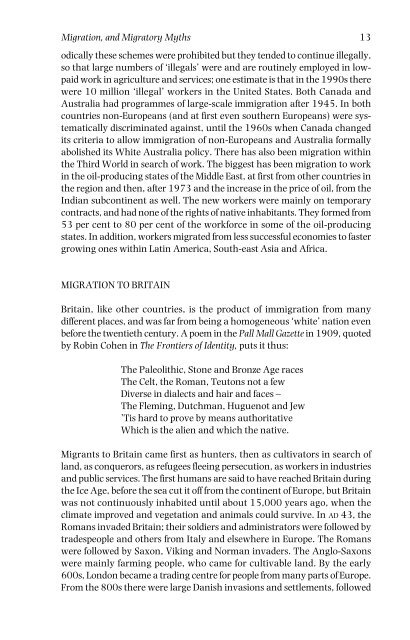Open%20borders%20The%20case%20against%20immigration%20controls%20-%20Teresa%20Hayter
Open%20borders%20The%20case%20against%20immigration%20controls%20-%20Teresa%20Hayter
Open%20borders%20The%20case%20against%20immigration%20controls%20-%20Teresa%20Hayter
Create successful ePaper yourself
Turn your PDF publications into a flip-book with our unique Google optimized e-Paper software.
Migration, and Migratory Myths 13<br />
odically these schemes were prohibited but they tended to continue illegally,<br />
so that large numbers of ‘illegals’ were and are routinely employed in lowpaid<br />
work in agriculture and services; one estimate is that in the 1990s there<br />
were 10 million ‘illegal’ workers in the United States. Both Canada and<br />
Australia had programmes of large-scale immigration after 1945. In both<br />
countries non-Europeans (and at first even southern Europeans) were systematically<br />
discriminated against, until the 1960s when Canada changed<br />
its criteria to allow immigration of non-Europeans and Australia formally<br />
abolished its White Australia policy. There has also been migration within<br />
the Third World in search of work. The biggest has been migration to work<br />
in the oil-producing states of the Middle East, at first from other countries in<br />
the region and then, after 1973 and the increase in the price of oil, from the<br />
Indian subcontinent as well. The new workers were mainly on temporary<br />
contracts, and had none of the rights of native inhabitants. They formed from<br />
53 per cent to 80 per cent of the workforce in some of the oil-producing<br />
states. In addition, workers migrated from less successful economies to faster<br />
growing ones within Latin America, South-east Asia and Africa.<br />
MIGRATION TO BRITAIN<br />
Britain, like other countries, is the product of immigration from many<br />
different places, and was far from being a homogeneous ‘white’ nation even<br />
before the twentieth century. A poem in the Pall Mall Gazette in 1909, quoted<br />
by Robin Cohen in The Frontiers of Identity, puts it thus:<br />
The Paleolithic, Stone and Bronze Age races<br />
The Celt, the Roman, Teutons not a few<br />
Diverse in dialects and hair and faces –<br />
The Fleming, Dutchman, Huguenot and Jew<br />
’Tis hard to prove by means authoritative<br />
Which is the alien and which the native.<br />
Migrants to Britain came first as hunters, then as cultivators in search of<br />
land, as conquerors, as refugees fleeing persecution, as workers in industries<br />
and public services. The first humans are said to have reached Britain during<br />
the Ice Age, before the sea cut it off from the continent of Europe, but Britain<br />
was not continuously inhabited until about 15,000 years ago, when the<br />
climate improved and vegetation and animals could survive. In AD 43, the<br />
Romans invaded Britain; their soldiers and administrators were followed by<br />
tradespeople and others from Italy and elsewhere in Europe. The Romans<br />
were followed by Saxon, Viking and Norman invaders. The Anglo-Saxons<br />
were mainly farming people, who came for cultivable land. By the early<br />
600s, London became a trading centre for people from many parts of Europe.<br />
From the 800s there were large Danish invasions and settlements, followed


